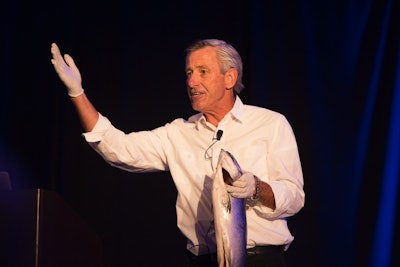 Jim Donald, former CEO of retail businesses, spoke during the CCJ Solutions Summit. Photo by Ian Holl
Jim Donald, former CEO of retail businesses, spoke during the CCJ Solutions Summit. Photo by Ian HollAt the CCJ Solutions Summit, Nov. 13, in Palm Springs, Calif., fleet executives and managers received some timely advice from the former CEO of Starbucks, Pathmark Supermarkets and Extended Stay Hotels.
“Our workforce is changing and it’s changing quickly,” said Jim Donald, who lead turnaround efforts at these companies by using creative methods to engage employees in the work.
Referencing a 2015 study from Microsoft, Donald said that a goldfish now has a longer attention span than the average human. A goldfish patiently waits for nine seconds as food flakes fall in a fishbowl. By comparison, the attention span of the average human is eight seconds. More concerning is that the attention span has dropped four seconds since 2012.
“Just think — if you only had eight seconds to coach, to counsel, to mentor or to train a driver because of his attention span, you’d find out that you would do things differently,” he said.
The challenge for leadership in the 21st Century, he said, is to set a clear, concise message that people will understand and use to get things done.
During his presentation at the CCJ Solutions Summit, Donald shared the following strategies he has used in his career to get companies through peaks and valleys — including bankruptcy.
The science of storytelling
To capture the attention span of employees, leaders need to understand the science of storytelling. As an example, Donald told a “fish story” to the employees, vendors and investors of Pathmark Supermarkets in 1997 to help them realize the gravity of the situation.
 Jim Donald encouraged transportation leaders to create their own “fish story” to make urgent business understandable for everyone in the company.
Jim Donald encouraged transportation leaders to create their own “fish story” to make urgent business understandable for everyone in the company.In the Spring of 1997, the $5 billion company was teetering towards bankruptcy when he gathered 1,800 associates together one morning at a Hilton hotel in Newark, NJ. While speaking to his associates he paused, put on plastic gloves, and pulled a salmon from a cooler.
In the final days of a salmon’s life it takes one final trip upstream to a certain location to spawn, he explained.
“We are a salmon, that’s all we are. We are not going to make it,” he said. “As a failing company, we are taking a trip. This fish when it swims upstream is faced with bears and eagles that want to snatch it. Bankers and landlords want to take our company.”
By explaining the situation in a way everyone could understand, “it was like all of a sudden a light switch turned on,” he said. The story helped rally the troops to take action, and he was “able to tell associates that a new day is coming.”
Donald sent out a 30-second voice mail message every day to all employees and the company successfully emerged from bankruptcy in 68 days. It later become publicly traded.
Donald gave the fish story as an example of how to communicate business needs to employees in short, concise messages. He also gave several examples of what can happen when companies do not have a “fish story” that employees understand and use to guide their actions.
In less than one year, United Airlines dropped from a $24 billion market valuation to $17 billion. The downfall began when flight attendants dragged a passenger off an overbooked flight. Similarly, ride sharing company Uber has fallen from an estimated $200 billion valuation at its peak to $60 billion following a string of bad publicity triggered by its former CEO.
“If I was your chief trucking czar, I would be telling you, as an individual, that you’ve got to have a fish story that people can remember. If you don’t, somebody else is going to write it for you,” he said.
The other strategies Donald talked about can be summarized as:
- Front line leadership. Engage with front-line employees and support their work.
- Go where you’ve never gone before. Get to know your business by listening to people on the front lines.
- Encourage risk taking with the freedom to fail. Give employees a “get out of jail for free” card to encourage them they try something new — without breaking any legal or ethical boundaries, of course. “Risk aversion creates stagnation,” he said. “Get your associates to be able to make decisions.”
- It starts with you. Be eager to learn and listen, just like you were on the first day of the job.
“You have to be the generator of this new associate that is going to be part of your business,” he said. “If you think back to your first day of anything, think about how you felt, how you acted, and how you listened. Convert yourself to your freshman day and you will find more success in your own four walls.”












